NEET Previous Year Questions(2016-24): Morphology of Flowering Plants | Biology Class 11 PDF Download
2024
Q1: Identify the type of flowers based on the position of calyx, corolla and androecium with respect to the ovary from the given figures (a) and (b) (a) (a) Epigynous; (b) Hypogynous
(a) (a) Epigynous; (b) Hypogynous
(b) (a) Hypogynous; (b) Epigynous
(c) (a) Perigynous; (b) Epigynous
(d) (a) Perigynous; (b) Perigynous
Ans: (d)
If gynoecium is situated in the centre and other parts of the flower are located on the rim of the thalamus almost at the same level, it is called perigynous.
Both diagram shows perigynous condition.
Q2: Which of the following is an example of actinomorphic flower? (NEET 2024)
(a) Datura
(b) Cassia
(c) Pisum
(d) Sesbania
Ans: (a)
The correct answer is: Option A: Datura
An actinomorphic flower is one that can be divided into two equal halves along any plane passing through its center. This is also known as radial symmetry.
Datura flowers exhibit radial symmetry, as their petals are arranged in a circular pattern around the center.
The other options are incorrect:
- Cassia: Zygomorphic (bilateral symmetry)
- Pisum: Zygomorphic (bilateral symmetry)
- Sesbania: Zygomorphic (bilateral symmetry)
Q3: Match List I with List II (NEET 2024)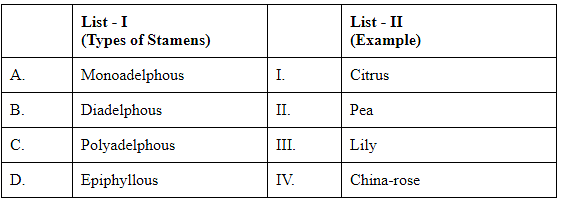 (a) A-IV, B-II, C-I, D-III
(a) A-IV, B-II, C-I, D-III
(b) A-IV, B-I, C-II, D-III
(c) A-I, B-II, C-IV, D-III
(d) A-III, B-I, C-IV, D-II
Ans: (a)
The correct answer is: Option A: A-IV, B-II, C-I, D-III
Monoadelphous: Stamens united into a single bundle by their filaments. Example: China rose
Diadelphous: Stamens united into two bundles by their filaments. Example: Pea
Polyadelphous: Stamens united into more than two bundles by their filaments. Example: Citrus
Epiphyllous: Stamens arise from the perianth (sepals and petals) rather than from the receptacle. Example: Lily
Q4: Match List I with List II (NEET 2024)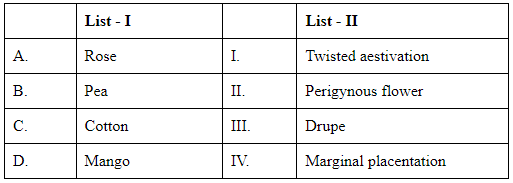 Choose the correct answer from the options given below :
Choose the correct answer from the options given below :
(a) A-II, B-IV, C-I, D-III
(b) A-I, B-II, C-III, D-IV
(c) A-IV, B-III, C-II, D-I
(d) A-II, B-III, C-IV, D-I
Ans: (a)
Rose have half-inferior ovary, thus it is known as Perigynous flower.
In Pea, the placenta form a ridge along the ventral suture of the ovary and ovules are borne on this ridge forming two rows.
In Cotton, twisted aestivation is present.
In Mango, fruit is drupe.
Q5: Identify the part of the seed from the given figure which is destined to form root when the seed germinates.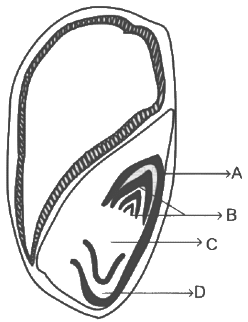 (a) A
(a) A
(b) B
(c) C
(d) D
Ans: (c)
Sol: The radicle is the part of the seed that will develop into the root when the seed germinates.
In the provided diagram, 'C' represents the radicle.
2023
Q1: Family Fabaceae differs from Solanaceae and Liliaceae. With respect to the stamens, pick out the characteristics specific to family Fabaceae but not found in Solanaceae or Liliaceae. (NEET 2023)
(a) Diadelphous and Dithecous anthers
(b) Polyadelphous and epipetalous stamens
(c) Monoadelphous and Monothecous anthers
(d) Epiphyllous and Dithecous anthers
Ans: (a)
- Fabaceae → Diadelphous and dithecous anther.
- Solanaceae → Polyandrous, epipetalous and dithecous anther.
- Liliaceae → Polyandrous, epiphyllous and dithecous anther.
Q2: Given below are two statements : One is labelled as Assertion A and the other is labelled as Reason R :
Assertion A : A flower is defined as modified shoot wherein the shoot apical meristem changes to floral meristem.
Reason R : Internode of the shoot gets condensed to produce different floral appendages laterally at successive node instead of leaves.
In the light of the above statements, choose the correct answer from the options given below : (NEET 2023)
(a) Both A and R are true but R is NOT the correct explanation of A
(b) A is true but R is false
(c) A is false but R is true
(d) Both A and R are true and R is the correct explanation of A
Ans: (d)
- Statement A is true. A flower is indeed a modified shoot wherein the shoot apical meristem changes to a floral meristem.
- Statement R is also true. In the process of flower formation, the internodes of the shoot get condensed, and instead of leaves, different floral appendages (such as sepals, petals, stamens, and carpels) are produced laterally at successive nodes.
- Moreover, Statement R is indeed the correct explanation for Statement A. The transition from the shoot apical meristem to the floral meristem involves the condensation of internodes and the lateral production of floral appendages at nodes, which leads to the formation of a flower.
2022
Q1: Which of the following statement is not correct? (NEET 2022 Phase 2)
(a) The rhizome is thick, prostrate and branched
(b) Rhizome is a condensed form of stem
(c) The apical bud in rhizome always remains above the ground
(d) The rhizome is aerial with no distinct nodes and internodes
Ans: (d)
Rhizome is an underground (sub-aerial) stem. It bears distinct nodes and internodes.
Q2: The type of tissue commonly found in the fruit wall of nuts is : (NEET 2022 Phase 2)
(a) Sclereid
(b) Parenchyma
(c) Collenchyma
(d) Sclerenchyma
Ans: (a)
The sclereids are the spherical, oval or cylindrical, highly thickened dead cells with very narrow cavities (lumen). These are found commonly in the fruit wall of nuts.
Q3: Match List - I with List - II : (NEET 2022 Phase 2)
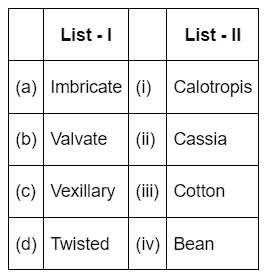
Choose the correct answer from the options given below
(a) - (a) - (i), (b) - (iii), (c) - (iv), (d) - (ii)
(b)- (a) - (ii), (b) - (i), (c) - (iii), (d) - (iv)
(c) - (a) - (ii), (b) - (i), (c) - (iv), (d) - (iii)
(d) - (a) - (ii), (b) - (iv), (c) - (iii), (d) - (i)
Ans: (d)
- Imbricate aestivation is found in Cassia
- Valvate aestivation is found in Calotropis
- Vexillary aestivation is found in Bean
- Twisted aestivation is found in cotton
Q4:The Floral Diagram represents which one of the following families? (NEET 2022 Phase 2)
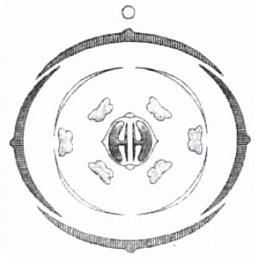 (a) Liliaceae(b) Fabaceae(c) Brassicaceae(d) SolanaceaeAns: (c)
(a) Liliaceae(b) Fabaceae(c) Brassicaceae(d) SolanaceaeAns: (c)
The floral diagram given in the question represents Brassicaceae family. It can be easily identified by looking on its parietal placentation.
Q5: Which one of the following plants shows vexillary aestivation and diadelphous stamens? (NEET 2022 Phase 1)
(a) Pisum sativum
(b) Allium cepa
(c) Solanum nigrum
(d) Colchicum autumnale
Ans: (a)
- Vexillary aestivation and diadelphous stamens are the characteristic features of family Fabaceae.
- Pisum sativum (garden pea) belongs to family Fabaceae.
- Allium cepa (onion) and Colchicum autumnale (colchicine) belong to family Liliaceae.
- Solanum nigrum belongs to Solanaceae.
Q6: Identify the correct set of statements: (NEET 2022 Phase 1)
(a) The leaflets are modified into pointed hard thorns in Citrus and Bougainvillea
(b) Axillary buds form slender and spirally coiled tendrils in cucumber and pumpkin
(c) Stem is flattened and fleshy in Opuntia and modified to perform the function of leaves
(d) Rhizophora shows vertically upward growing roots that help to get oxygen for respiration
(e) Subaerially growing stems in grasses and strawberry help in vegetative propagation
Choose the correct answer from the options given below:
(a) (b) and (c) only
(b) (a) and (d) only
(c) (b), (c), (d) and (e) only
(d) (a), (b), (d) and (e) only
Ans: (c)
Axillary buds of stems get modified into woody, straight and pointed thorns. Thorns are found in many plants such as Citrus and Bougainvillea.
Q7: The flowers are Zygomorphic in: (NEET 2022 Phase 1)
(A) Mustard
(B) Gulmohar
(C) Cassia
(D) Datura
(E) Chilly
Choose the correct answer from the options given below:
(a) (B), (C) Only
(b) (D), (E) Only
(c) (C), (D), (E) Only
(d) (A), (B), (C) Only
Ans: (a)
When a flower can be divided into two similar halves only in one particular vertical plane, it is zygomorphic for e.g. pea, gulmohar, bean, Cassia. Mustard, Datura and Chilly show actinomorphic flowers.
Q8: Which part of the fruit, labelled in the given figure make it a false fruit: (NEET 2022 Phase 1)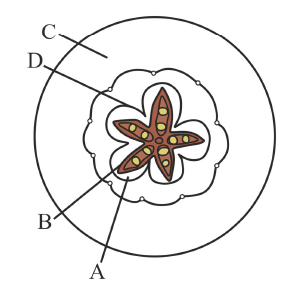
(a) B → Endocarp
(b) C → Thalamus
(c) D → Seed
(d) A → Mesocarp
Ans: (b)
The given figure is of a false unit. False fruit develops from other floral parts and thalamus alongwith the development of ovary wall.
2021
Q1: Match Column-I with Column-II (NEET 2021)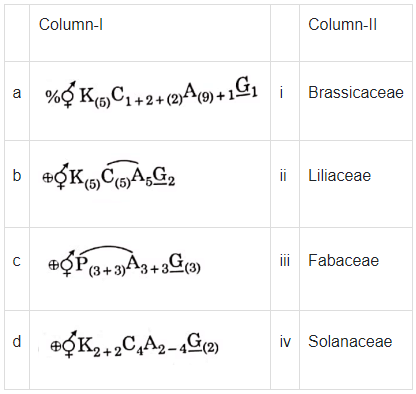
Select the correct answer from the options given below.
(a) (b) (c) (d)
(a) (ii) (iii) (iv) (i)
(b) (iv) (ii) (i) (iii)
(c) (iii) (iv) (ii) (i)
(d) (i) (ii) (iii) (iv)
Ans: (c)
The floral formula of

So, a(iii), b(iv), c(ii), d(i) is correct matching.
2020
Q1: Ray florets have (NEET 2020)
(a) Superior ovary
(b) Hypogynous ovary
(c) Half inferior ovary
(d) Inferior ovary
Ans: (d)
Ray floret have inferior ovary. Ray floret is condition in flower where any of a number of strap-shaped and typically sterile florets that form the ray e.g., Sunflower Epigynous flower are formed in family Asteraceae.
Q2: The ovary is half inferior in: (NEET 2020)
(a) Mustard
(b) Sunflower
(c) Plum
(d) Brinjal
Ans: (c)
The ovary is half inferior in Plum. A half inferior ovary is embedded or surrounded by the receptacle. Such flowers are termed perigynous or half-epigynous. In some classifications, half-inferior ovaries are not recognized and are instead grouped with either the superior or inferior ovaries.
2019
Q1: Grass leaves curl inward during very dry weather. Select the most appropriate reason from the following : (NEET 2021)
(a) Shrinkage of air spaces in spongy mesophyll
(b) Tyloses in vessels
(c) Closure of stomata
(d) Flaccidity of bulliform cells
Ans: (d)
Flaccidity of bulliform cells grass leaves curl in words during dry weather due to the loss of water or flaccidity of bulliform cells.
2018
Q1: Sweet potato is a modified (NEET 2018)
(a) Stem
(b) Adventitious root
(c) Tap root
(d) Rhizome
Ans: (b)
Adventitious roots of sweet potato, get swollen and store food. Where as rhizome is fleshy underground stem eg. Ginger, Turmeric.
2017
Q1: Coconut fruit is a (NEET 2017)
(a) Berry
(b) Nut
(c) Capsule
(d) Drupe
Ans: (d)
Coconut fruit is a drupe. A drupe is a fleshy fruit with thin skin and central stone containing the seed.
Q2: In Bougainvillea, thorns are the modifications of (NEET 2017)
(a) Adventitious root
(b) Stem
(c) Leaf
(d) Stipules
Ans: (b)
Thorns are hard, pointed straight structures for protection against grazing animal. These are modified stem.
Q3: The morphological nature of the edible part of coconut is (NEET 2017)
(a) Cotyledon
(b) Endosperm
(c) Pericarp
(d) Perisperm
Ans: (b)
The edible part of coconut is its endosperm. Coconut has double endosperm, liquid endosperm and cellular.
2016
Q1: The term ‘polyadelphous’ is related to (NEET 2016 Phase 2)
(a) Gynoecium
(b) Androecium
(c) Corolla
(d) Calyx
Ans: (b)
Polyadelphous condition represents cohesion of stamens. In this condition stamens of a flower are fused by their filaments only to form many groups, e.g., Citrus.
Q2: Free central placentation is found in (NEET 2016 Phase 2)
(a) Dianthus
(b) Argemone
(c) Brassica
(d) Citrus
Ans: (a)
Free central placentation is found in Dianthus. Parietal placentation is present in Argemone and Brassica whereas Citrus has axile placentation in ovary.
Q3: How many plants among Indigofera, Sesbania, Salvia, Allium, Aloe, mustard, groundnut, radish, gram and turnip have stamens different lengths in their flowers? (NEET 2016 Phase 2)
(a) Three
(b) Four
(c) Five
(d) Six
Ans: (b)
The question about plants with flowers having stamens of different lengths refers to a condition called "heterostyly" or "didynamous" and "tetradynamous" stamens in some cases. This is a characteristic feature in some flowering plants where the stamens (the male reproductive parts) are of unequal length.
Let's evaluate the plants listed :
- Indigofera - Members of the Fabaceae family, like Indigofera, typically have uniform stamen lengths.
- Sesbania - Also a member of the Fabaceae family, similar to Indigofera, likely has uniform stamen lengths.
- Salvia - Belonging to the Lamiaceae family, Salvia exhibits didynamous stamens (four stamens with two different lengths).
- Allium - A member of the Amaryllidaceae family, Allium species generally have stamens of equal length.
- Aloe - A member of the Asphodelaceae family, Aloe species usually have stamens of equal length.
- Mustard - Belonging to the Brassicaceae family, mustard plants exhibit tetradynamous stamens (six stamens with four of one length and two of another).
- Groundnut - A member of the Fabaceae family, groundnut likely has uniform stamen lengths.
- Radish - Part of the Brassicaceae family, radish plants also exhibit tetradynamous stamens.
- Gram (Chickpea) - Belonging to the Fabaceae family, gram typically has uniform stamen lengths.
- Turnip - As a member of the Brassicaceae family, turnip plants have tetradynamous stamens.
Based on this evaluation, the plants among the list that have stamens of different lengths in their flowers are Salvia, Mustard, Radish, and Turnip. Therefore, the correct answer is Option B : Four.
Q4: Radial symmetry is found in the flowers of (NEET 2016 Phase 2)
(a) Brassica
(b) Trifolium
(c) Pisum
(d) Cassia
Ans: (a)
The flowers of Brassica are radially symmetrical whereas flowers of Trifolium, Pisum and Cassia are zygomorphic.
Q5: Which of the following is not a stem modification? (NEET 2016 Phase 1)
(a) Tendrils of cucumber
(b) Flattened structures of Opuntia
(c) Pitcher of Nepenthes
(d) Thoms of citrus
Ans: (c)
Pitcher of Nepenthes or pitcher plant is modification of leaf whereas thorns in citrus tendrils of cucumber and flattened structure of Opuntia are all stem modification.
Q6: Stems modified into flat green organs performing the functions of leaves are known as (NEET 2016 Phase 1)
(a) Phylloclades
(b) Scales
(c) Cladodes
(d) Phyllodes
Ans: (a)
Phylloclades are flattened green stems which have taken over the function of photosynthesis while cladodes are only the branches of stem that are modified to take over the function of leaves. Cladodes may not be flattened as in Ruscus aculeatus, cladodes are leaf-like with spiny tip whereas in Asparagus, they are slightly flattened, fleshy, straight or curved pointed structures which develop in clusters in the axil of scale leaves.
Q6: Cotyledon of maize grain is called (NEET 2016 Phase 1)
(a) Coleoptile
(b) Scutellum
(c) Plumule
(d) Coleorhiza
Ans: (b)
The cotyledons are known as seed leaves, they are attached to the embryonic axis. Dicotyledons typically have two cotyledons and monocotyledons have only one cotyledon. The single shield-shaped cotyledon in grains known as scutellum.
Q7: Tricarpellary, syncarpous gynoecium is found in flowers of (NEET 2016 Phase 1)
(a) Fabaceae
(b) Poaceae
(c) Liliaceae
(d) Solanaceae
Ans: (c)
The Liliaceae are a huge variety, comprising about 280 genera and 4000 species of perennial herbs mostly. It includes starchy rhizomes, corms or bulbs, characterized by alternate leaves which are whorled. The flowers are often showy, mostly bisexual and actinomorphic. Also, they exhibit tricarpellary syncarpous gynoecium. Example of such a class is the Erythronium montanum, the alpine fawn lily
Q8: The standard petal of a papilionaceous corolla is also called (NEET 2016 Phase 1)
(a) Vexillum
(b) Corona
(c) Carina
(d) Pappus
Ans: (a)
Papilionaceous flowers are flowers with the characteristic irregular and butterfly-like corolla. A single, large upper petal is known as the banner or vexillum and the name has been derived from an ancient military standard.
|
181 videos|361 docs|148 tests
|
FAQs on NEET Previous Year Questions(2016-24): Morphology of Flowering Plants - Biology Class 11
| 1. What is the importance of studying the morphology of flowering plants for NEET exam preparation? |  |
| 2. How can a student effectively study the morphology of flowering plants for the NEET exam? |  |
| 3. What are some common types of questions related to the morphology of flowering plants in the NEET exam? |  |
| 4. How can understanding the morphology of flowering plants help in solving complex NEET exam questions? |  |
| 5. Are there any specific topics within the morphology of flowering plants that are frequently tested in the NEET exam? |  |

|
Explore Courses for NEET exam
|

|


















